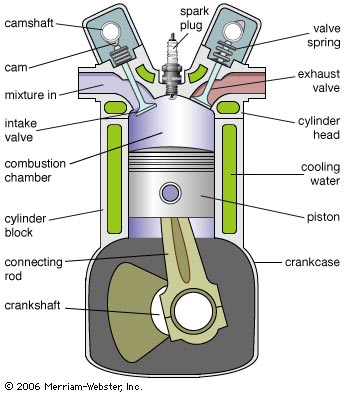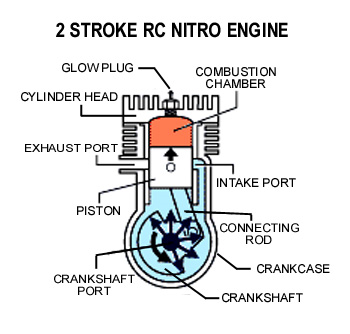Summary
The aim of this report is to outline the operation of internal combustion engines. Internal combustion engines are engines in which the fuel and air burns within a combustion chamber. There are two types of combustion engines: spark ignition and compression ignition. In the report, these two types of engines will be elaborated upon plus the two and four stroke cycles upon which they can operate. The different parts of the internal combustion engine will also be outlined and their functions stated.
Introduction
The internal combustion engine is a type of engine in which air and fuel burns within a combustion chamber. Useful mechanical energy is produced by the force imparted on a moving part (e.g. a piston) by the high pressure resulting from the rapid expansion of the air fuel mixture (Khemani, 2008a).There are two common types of internal combustion engines; The compression ignition and spark ignition types.
Spark ignition engines (Otto engines) operate on the Otto cycle principle invented by Nicolaus Otto in 1876 while the compression ignition engines (diesel engines) operate on Rudolph Diesel’s cycle.
Diesel and Otto engines work in a very similar way. Their main difference comes in the way in which the air fuel mixture (charge) is ignited.In Otto engines, spark plugs fitted in the cylinder head are used to ignite the charge. In Diesel engines, on the other hand, the air is compressed to exceedingly high pressures that result to high temperatures and ignition of the diesel upon injection. This eliminates the need for a spark plug and the charge then burns at a constant pressure (Khemani, 2008a). Both Diesel and Otto cycles can be built to work with two or four strokes.
Four-stroke engine
In the four stroke engine, suction, compression, expansion and exhaust of the waste gases is achieved in four strokes of the piston in the cylinder i.e. the intake, compression, power stroke and exhaust stroke. Two revolutions of the engine crankshaft result in these four strokes and useful mechanical energy is produced during the power stroke as the high pressure expanding gases impart a force on the piston (Satyanarayana, 2008).
The internal combustion engine
The internal combustion engine components of a four stroke engine are shown in fiugure 1 and their functions are oultlined below.

Cams and valves
The camshaft is used as the actuater for the valves during the strokes while the valve spring keeps the valves in place and stops them fom wobbling. The inlet valves let in fresh air (oxidiser) during the intake stroke while the exhaust valves let out the exhaust gases in the exhaust stroke.
Casings
The Crankcase houses the oil pan and the area in which the connecting rod oscilates.The Cylinder head on the other hand carries the valves and spark plugs while the Cylinder block houses the cylinder and jackets for the coolant.
The Spark plug Ignites the the fuel air mixture in spark ignition engines.
Moving parts
The Piston sucks in the freshair,compresses the air during compression and pushes out exhaust gases.The Connecting rod changes the reciprocating motion of the piston into rotary motion which is the transmitted to the drive wheels through the Crank shaft.
NB In the case of a diesel engine,the spark plug is replaced by a fuel injector which sprays fine spary of fuel into the cylinder during the compression stroke.
In compression ignition engines, spark plugs are not employed but high pressures are utilized instead. The fuel air is compressed to a very high pressure which raises its temperature to a very high value; this then leads to spontaneous ignition of diesel on injection as diesel burns by itself at very high temperatures (Khemani, 2008b).
Operation of the Compression Ignition 4 stroke engine
The compression ignition engines work in four strokes that are described below:
Suction stroke
The suction stroke lets in the oxidizer into the cylinder.This stroke starts with the piston at the top dead center (TDC).The piston then moves down and the inlet valve is opened.Air is drawn into the cylinder via the inlet valve as the piston moves down to the bottom dead center (BDC).During this time the outlet valve remains closed. This stroke ends when the piston reaches the BDC.
Compression stroke
This stroke is responsible for raising the air temperature and pressure. During this stroke, the piston moves from the BDC towards the TDC. During its travel, it compresses the air in a compression ratio of about 16-20(compared to 6-10 in SI engines).During this time both the inlet and exhaust valves remain closed.
Power stroke
This is the stroke that gives out useful energy. As the piston approaches the TDC, diesel is injected into the combustion chamber. The diesel is instantly ignited due to the very high temperature of the compressed air. This ignition and combustion gives out massive thermal energy which raises the pressure due to rapid expansion of the mixture. This leads to the piston moving down rapidly rotating the crankshaft and giving mechanical power. The inlet and outlet valves remain closed during this stroke that ends when the piston reaches the BDC.
Exhaust stroke
The exhaust stroke removes the waste gases after combustion. After the power stroke, the combustion residual gases still remain in the cylinder. It is during the exhaust stroke that the outlet valve opens and lets out the exhaust gases as the piston moves from the BDC to the TDC. Once the piston reaches the TDC and all the exhaust gases are out, the cycle begins again (Mechtech, 2009).
Operation of the spark Ignition 4 stroke engine
The spark ignition engine works in a similar manner to compression ignition engines save for a few details in the mode of igniting the fuel and the pressures involved. The cycles for this engine are described below.
Intake Stroke
As the piston moves from TDC down, the inlet valve opens and the air fuel mixture in drawn in.
Compression Stroke
The inlet and outlet valves remain closed as the piston moves up from the BDC to TDC compressing the charge (air-fuel mixture).Just before the end of this stroke, the spark ignites the charge.
Combustion Stroke
Combustion and rapid expansion of the air fuel mixture forces the piston down transmitting mechanical energy to the crankshaft via the connecting rod.
Exhaust Stroke
During this stroke, the exhaust valve opens letting out the exhaust gases as the piston moves up from the BDC to TDC. At the end of this stroke, the outlet valve is closed and then a new set of strokes begins
NB The main difference between the Spark ignition(SI) and compression ignition(CI) is that during the intake stroke for CI only air is taken in and compressed with fuel only being introduced after the air is hot and compressed, while for SI, the air-fuel mixture is drawn in and compressed as a mixture.
The two stroke engine

In the two stroke engine on the other hand, inlet, compression, power and exhaust are all achieved in just two strokes. This is achieved by building the engine such that the compression stroke doubles as the intake stroke. As the piston moves upward, air is let in via the inlet valve. The power stroke on the other hand doubles as the exhaust stroke. The valves used in the four stroke engine are replaced by strategically placed inlet and outlet ports as can be seen in figure 2.
It has been observed that the four stroke engine is more efficient as it burns fuel once for two rotations of the crankshaft while the two stroke burns once per rotation. The two-stroke engine however produces more power because it offers more power strokes (Mechtech, 2009).
This two stroke construction results in very high specific power and efficiency because the number of power strokes, for a given number of revolutions, is doubled. This has made two stroke engines very popular especially among low power applications e.g. lawn mowers and small motor bikes.
Conclusion
The internal combustion engine is very important in the Mechanical Engineering field. It is instrumental because it has been used in the manufacture vehicles and water vessels. Operation of this engine was studied and the different versions (two stroke, four stroke, compression ignition and spark ignition) compared and contrasted. The mode of operation of the different systems was also clearly outlined.
List of references
Four Stroke Engine, 2006.[Merriam Webster]. Web.
Khemani , H.,2008a. How a Four-Stroke Spark Ignition (SI) Engine Works. Web.
Khemani , H.,2008b.Working Principle of Internal Combustion Engines. Web.
Mechtech, 2009.Working of Diesel Engine Injection System. Web.
Satyanarayana, A., 2008. Internal Combustion Engine: How They Develop the Power to Propel Vehicles – Part 1(of 3). Web.
Two Stroke Nitro Engine, 1995. Web.